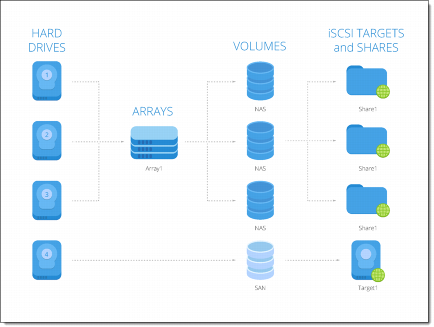Storage
How Does Storage Work On a Cloud Storage Gateway?
Storage on a CTERA C-Series Cloud Storage Gateway (C200, C400, C800/C800+) is set up by adding hard drives for physical storage, and then virtualizing that storage in the best way for your needs, the amount of storage you have, and the number of drives. You usually create an array to combine your drives into a larger pool of storage, set up redundancy between drives, and/or increase performance. Once you've set up an array, you can create logical units of storage, called volumes.
Similarly, you can define additional virtual disks on the Virtual Gateway and then create volumes. The Virtual Gateway supports the definition of up to 16 virtual disks. Depending on your license, it is possible to enlarge the virtual disks via the hypervisor or AWS management interface.
Both C-Series and Virtual Gateway gateways support SAN volumes and NAS volumes. SAN volumes can be exposed to servers by creating iSCSI targets. NAS volumes are accessible through file access protocols. You can create folders on NAS volumes and store files in the folders. You can also define folders as network shares and share them across the network, via several protocols.
Can I use storage volumes as separate drives accessed by different remote servers?
Yes, you can create a SAN type volume for each remote machine. Then create an iSCSI target to expose each volume to each server. You can then mount each iSCSI target as a drive on each server and use as you would use any hard drive.
How do I control storage allocation?
• Per share: You can limit the size of a shared folder by creating a specific volume to store that folder.
Is there a quick way to get the storage set up and ready to go?
Yes, once you've installed hard drives or additional virtual disks, you can run the
Easy Storage Setup wizard to choose and create the optimal type of array and one volume on that array.

